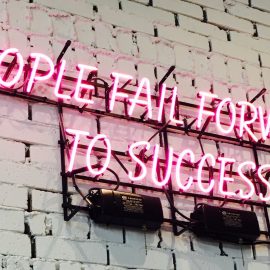
What’s Let My People Go Surfing by Yvon Chouinard about? How does the clothing company Patagonia help the environment?
According to Let My People Go Surfing, Patagonia was founded as an eco-friendly company that’s conscious of its environmental footprint. Founder Yvon Chouinard shares how he grew from a nature enthusiast to the founder of the company.
Read below for a brief overview of Let My People Go Surfing.
Let My People Go Surfing by Yvon Chouinard
From its origin as a modest rock climbing equipment shop, Patagonia has become not only a globally recognized outdoor gear and apparel company but also a beacon of sustainable business. In Let My People Go Surfing, founder Yvon Chouinard shares his journey from nature enthusiast to creator of the eco-friendly company. He critiques traditional profit-first business practices and encourages companies to be conscious of their environmental footprint in Let My People Go Surfing. Patagonia’s unique business model helps Chouinard demonstrate that success is possible when a company puts its customers, employees, and the planet before profits.
Part 1: Chouinard’s Journey From Adventurer to Entrepreneur
Chouinard writes that it was his deep passion for the outdoors that propelled him into the world of entrepreneurship. As someone who disliked authority and considered himself a “dirtbag”—a person who dedicates their life to outdoor pursuits—he never intended to become a traditional businessman. Instead of pursuing success or profit, Chouinard became an entrepreneur primarily as a means to fund his climbing trips. Thus, a dedication to nature has been at the heart of Patagonia from the beginning.
Chouinard developed his love for the outdoors early in life. Born in Maine, he moved with his family to California when he was a young boy. He writes that he wasn’t a good student and often felt like an outsider, so he found refuge in the outdoors—fishing, hunting, and eventually joining a falconry club that introduced him to rock climbing.
Chouinard Equipment: An Early Commitment to Putting the Environment First
Chouinard’s entrepreneurial journey began with his dissatisfaction with existing climbing gear, which inspired him to create his own. He started crafting pitons—metal spikes that climbers hammer into rock to attach their ropes to. To reduce the environmental impact of climbing, Chouinard redesigned pitons to be reusable rather than left embedded in the rock after use, as was typical. Initially, Chouinard sold this climbing gear from the back of his car, but as demand for his gear increased, he set up Chouinard Equipment in a tin shed and hired friends to help out.
However, despite the popularity of his pitons, Chouinard quickly decided to discontinue the company’s flagship product because it still harmed the environment. Despite being reusable, pitons scarred the rock. Chouinard found a more sustainable alternative in the form of aluminum chocks, which could be wedged into the rock without causing damage. After Chouinard released an article about “clean climbing,” demand for the chocks skyrocketed. This decision demonstrated Chouinard’s true priorities: The environment mattered more to him than making money.
Part 2: The Rise of Patagonia
As Chouinard Equipment grew increasingly popular within the climbing community, Chouinard decided to expand and start a new company for outdoor apparel: Patagonia. Like with the climbing gear he manufactured, Chouinard wanted to produce clothing that was simple, practical, and durable. However, his transition from selling climbing hardware to clothing didn’t come without challenges. In this section, we’ll discuss the hurdles Patagonia had to overcome in its journey to success and how they shaped Chouinard’s unique, eco-friendly approach to business.
Early Challenges
After launching Patagonia, Chouinard quickly discovered that running an apparel business wasn’t the same as making climbing equipment. The young company encountered problems with a garment factory they had contracted with, resulting in late shipments and a large stock of low quality products. Because of this, Patagonia struggled to make enough money to stay in business.
These early obstacles left Chouinard with a realization: For Patagonia to succeed, he needed to become a real businessman. This was a hard pill to swallow—he saw how consumerism and unsustainable business practices had led to the deterioration of the natural world and felt conflicted about assuming a role in the industry. To resolve the dissonance between his values and the role he needed to adopt, Chouinard decided to only conduct his business according to his values and his commitment to the environment.
Part 3: Building an Environmentally Conscious Business
Chouinard came to a crucial conclusion: His company was struggling because its leaders weren’t aligned with its mission. He traced the root cause to a lack of proper training of new leadership. To solve this problem and reaffirm the company’s identity, Chouinard took his top managers on a trip to Patagonia—the region in South America and the company’s namesake. There, they came up with a set of core principles that continue to guide the company today.
Patagonia emerged from the crisis with a three-pronged mission: To make the best product, to cause no unnecessary environmental harm, and to use business as a force for solving the environmental crisis. This mission has endured: Despite having grown into a sizable company, Patagonia still focuses on putting the planet at the heart of its business philosophy and practices. In this section, we’ll examine Patagonia’s business principles that help the company balance profits and environmental sustainability.
Principle #1: Design High Quality Products
One of the core tenets of Patagonia’s business philosophy is to design high quality products that are built to last. Chouinard argues that one of the major reasons for the environmental crisis is that people buy too many products and consume too many resources. Quality products lead to less waste and less consumption compared with cheap products that are quickly discarded, so by creating products that last longer, Patagonia hopes to combat this wasteful consumption.
According to Chouinard, a high quality product is:
1. Functional. Patagonia designs its products to be as simple, practical, and multifunctional as possible. Each product begins with a function in mind—such as clothing to keep wearers warm and dry. This way, the company avoids adding unnecessary features that would complicate the products and waste resources.
2. Durable. Chouinard explains that the weakest component of a product determines its lifespan. For example, a jacket may have a sturdy fabric, but if the zipper is of poor quality, the jacket won’t be usable for long. With this in mind, Patagonia conducts rigorous tests on every part of a product to make sure that they all have the same durability. Their products last longer as a whole and make the most of the resources required to produce them.
3. Repairable. To minimize waste, Patagonia encourages its customers to repair worn products instead of throwing them away. They support this initiative through programs like Worn Wear, which allow customers to trade in used Patagonia clothing, and they also provide resources for people to repair their gear.
Principle #2: Manufacture Products Sustainably
Another guiding principle of Patagonia is sustainable production. According to Chouinard, it’s as important to monitor a product’s production process as it is to design a high quality product. Thus, Patagonia cares about the full life cycle of their products—from the moment they’re manufactured to the moment they fall into disuse.
Chouinard explains some ways Patagonia takes responsibility during its product production process:
First, the company focuses on forming strong relationships with the people and companies who manufacture its products. It does this by involving producers in the design process, choosing producers based on the quality of their work, and setting up the manufacturing process correctly the first time. It also requires all contributors to the process to abide by fair labor practices. This ensures that, even with the company’s large size, they create products that come as close to handmade quality as possible.
Second, Patagonia regularly investigates how its products are made. Chouinard argues that to be environmentally responsible, you must actively educate yourself about your business processes and seek more eco-friendly ways of creating products. For example, after researching how different clothing fibers are grown and what chemicals are commonly found in dyes, Patagonia was able to identify more eco-friendly alternatives and transition to organic cotton and less toxic dyes. By asking questions rather than turning a blind eye, the company continually seeks new ways to reduce its environmental cost.
Principle #3: Be Authentic
Rather than crafting an artificial or exaggerated public image, Patagonia focuses on authentically operating according to its core values and its mission to protect the environment. For instance, the company’s guiding principles stem from a love for nature, a sense of freedom, and a refusal to conform to corporate norms.
Instead of relying on typical advertising tactics, Patagonia adopts several methods to introduce people to their products:
1. Hire product enthusiasts. Chouinard writes that great products are best created by the people who would use them because they’ll have a first-hand understanding of what users need and desire. Patagonia, therefore, hires people who share its passion for the rugged outdoor life.
2. Share authentic stories. Patagonia produces a catalog that shares photos and stories of customers using their products in action. Instead of pushing sales, this catalog builds trust in the products based on people’s real-life experiences.
3. Focus on educating over advertising. Patagonia educates its customers in two ways: First, by providing thorough and accurate product descriptions and details, and second, by sharing stories that promote environmental sustainability.
Principle #4: Grow the Company Naturally
Another principle of Patagonia’s is that it prioritizes the health of the environment over profit. Chouinard argues that pushing rapid business growth is harmful for the environment because the bigger a business grows, the more natural resources it uses and the more consumerism it promotes. Thus, instead of trying to maximize growth and profits through advertising and other marketing efforts, Chouinard focuses on growing the company at a natural rate—one that’s determined by customer demand. He sees profits not as a goal just for their own sake but as a means to stay in business and to support the environment, and he argues that profits come naturally if you’re doing a good job.
One way Patagonia maintains its natural growth is by remaining a privately owned company not beholden to the expectations of external investors or shareholders. This allows the company to operate according to its core values and its environmental mission.
Principle #5: Nurture Employees By Giving Them Freedom, Trust, and Benefits
Another core tenet of Patagonia’s business philosophy is prioritizing the well-being of its employees. Chouinard writes that he wants Patagonia to be an enjoyable place to work—a place that feels familial rather than corporate and appeals to the independent and free-spirited “dirtbags” who represent what the company is all about. He traces these values back to the company’s early days when he forged climbing hardware with friends.
He contends that Patagonia spearheaded the trend of more casual workplaces by nurturing its employees in several ways:
1. Encouraging work-life balance. Patagonia promotes a rich and adventurous lifestyle among its employees with its “Let My People Go Surfing” flextime policy, which allows employees to work flexible hours as long as they get their work done without impacting the work of others. Patagonia employees can take time off for anything from catching an afternoon surf to furthering their education to caring for their children.
2. Eliminating hierarchies. Patagonia values open communication and collaboration over corporate bureaucracy, and as such, offers an egalitarian workspace with no private offices or special parking spaces. Chouinard argues that effective communication and a sense of equality encourage employees to feel accountable and motivate them to work efficiently and productively.
3. Offering on-site child care. Recognizing that it can be hard for working parents to find quality and affordable childcare, Patagonia manages several on-site child development centers that provide stimulating learning environments for children. The company also encourages parents to spend time with their children during the day. According to Chouinard, having employees’ children on-site creates a more comfortable, family-like atmosphere and increases employee happiness and productivity.
Principle #6: Implement Environmentally Friendly Practices
Lastly, Patagonia strives to use its influence and resources to fight the environmental crisis. Chouinard argues that businesses (like Patagonia) that use natural resources must take responsibility for the effects they have on the environment. He writes that many turn a blind eye to their environmental impact, engaging in wasteful practices to maximize profit and grow rapidly. He argues that to run a business while being environmentally conscious, businesses have to be willing to sacrifice short-term rewards for long-term gains.
Chouinard details a few ways Patagonia works to be more environment-friendly:
1. Reducing waste and energy consumption. Patagonia uses organic and recycled materials, such as organic cotton, hemp, recycled polyester, and recycled nylon. The company also reuses cardboard boxes and paper and has renovated its facilities to have energy-efficient lighting.
2. Donating to fight the environmental crisis. Chouinard recognizes that despite their best efforts, as a clothing company that uses up natural resources and produces products for people to consume, Patagonia will always exact some toll on the environment. Because of this, the company donates 1% of its sales to nonprofit environmental groups as a form of redress for staying in business. Since 1985, the company has given over $79 million to environmental organizations.
3. Encouraging other businesses to reduce their environmental footprint. Patagonia is not only a leader in sustainable business, but a catalyst for change in the industry. The company invests in environmentally responsible start-ups and openly shares its principles and workplace innovations so other businesses can become more sustainable.






